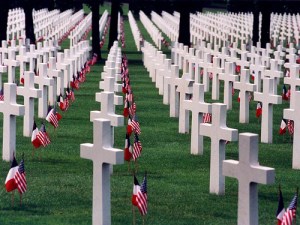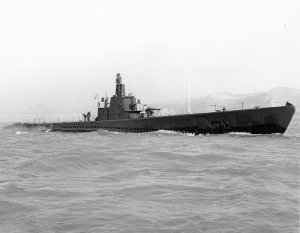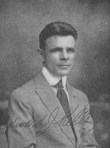
Fleet Admirals Chester W. Nimitz, Ernest J. King and Bill Halsey
I have always enjoyed reading American history, especially about both the American Civil War and World War II. One – a domestic conflict – determined the future course of America’s development as a “united nation”; the other – a world-wide conflict – resulted in America’s emergence as a global leader.
That’s not to say I have read everything out there on either subject. And from time-to-time I run across a book that teaches me a new thing or two. In the case of The Admirals, I gained a new perspective on America’s military leadership during the last world war to end all world wars.
Walter R. Borneman ‘s enlightening work focuses on the four admirals, who transcended the U.S. Navy’s pre-World War II rank hierarchy, to become the first five-star admirals in American history. This development was made necessary by the British Allies’ penchant for Fleet Admirals and Field Marshalls. The 5-star rank was added (by Act of Congress in June 1944) to the American military ranks to place U.S. admirals and generals on equal footing with their European counterparts.

Flag of the Fleet Admiral of the U.S. Navy
Five-star ranks of Fleet Admiral were bestowed on the four U.S. Navy Admirals and subjects of the book: William D. Leahy, Ernest J. King, Chester W. Nimitz, and William F. Halsey, Jr. Fifth stars have not been issued to a Navy officer since 1945 and the conclusion of World War II.
Prior to reading The Admirals I was much more familiar with the four U.S. Army Generals, who carried the five-star rank of General of the Armies: George C.Marshall, Douglas MacArthur, Dwight D. Eisenhower, and Henry H. Arnold. (Omar Bradley was added as a five-star General in 1950, the only officer in U.S. military service so honored after WWII.)
In The Admirals a new appreciation is gained for the leadership exhibited by two men often overlooked in most media presentations on the War in the Pacific. Those men are Admirals Leahy and King. Until I picked up The Admirals, I had no appreciation for the contributions they made in the prosecution of America’s WWII efforts.
The exploits and accomplishments of Admirals Nimitz and Halsey during the Pacific campaign are well-known and referred to relatively often. For instance, the other night I could not resist watching part of the movie, Midway in which Nimitz and Halsey are prominent. For that reason, the following speaks mostly of Bill Leahy and Ernest King.
____________________

Admirals King, top left and Leahy, behind FDR, at the Yalta Conference (June 1945)
Bill Leahy had been age-retired and was serving as Governor of Puerto Rico when the long-anticipated conflict with Japan broke with the attack on Pearl Harbor on December 7, 1941. His friendship with Franklin Delano Roosevelt, cultivated during a period in his Navy career when – as a Navy captain – Leahy ferried the then Assistant Secretary of the Navy up and down the U.S. eastern coast. Their relationship led to Leahy being named the Ambassador to Nazi-controlled Vichy, France when the Germans had overrun most of Western Europe.
Leahy’s role as ambassador was to influence the Vichy government from total subservience to the Nazi government, especially when it came to the remnants of the French fleet. When the Vichy eventually fell in line with the Nazis through the elevation of the pro-German Pierre Laval to the head of its government, FDR kept his promise to the previously retired Admiral Leahy; brought him home from France; and recalled him to military service to help fight the war.

Leahy, left, and King, top right, in conference with Generals George C. Marshall, right, and Henry “Hap” Arnold, top left
Tragedy befell Leahy as he prepared to leave the Vichy. His wife, Louise died suddenly from medical complications of a rushed hysterectomy performed in France.
In time Leahy came to be viewed by FDR and – almost as importantly – General George Marshall as the perfect candidate to become Chief of Staff to the Commander-in-Chief and Chairman of the Joint Chiefs of Staff. From this position Bill Leahy would not only coordinate the military’s strategic implementations with FDR’s global considerations, he became the man The President relied upon more and more for all manner of domestic and foreign policy execution.
Admiral Leahy accompanied President Roosevelt to most of the major war conferences, being left behind once in Tunis and missing Casablanca due to a high fever. He acted as a gatekeeper to information, communications, and personal access to FDR; coordinated execution of the both military and domestic presidential directives; and as Roosevelt’s health diminished, assumed responsibility for the daily functions of The Chief Executive.
The true testament to Admiral Bill Leahy’s effectiveness in those positions was his retention by Harry S Truman as his Chief of Staff for the entirety of his first term following FDR’s death in April 1945.
_______________

You gain keen insight from the earlier, less exciting chapters of The Admirals for the process through which the U.S. Navy ensures its officers and future leaders are well-rounded and thoroughly trained. In the pre-World War II chapters, Borneman concentrates on the early careers of his four study subjects. What is learned is the important role played by the Navy’s Bureau of Navigation (Bureau of Navy Personnel since 1942), an administrative position that controls the assignment and detailing of naval officers throughout the vast opportunities offered by Navy service. Each of the World War II five-stars is exposed to the various types of boats, ships and planes. From destroyers, to submarines, through cruisers, battleships and aircraft carriers …
Although none of the four officers Borneman follows gains experience in every possible Navy assignment, the reader sees how each officer’s background developed and how those experiences contributed to their efforts, ideas and strategies during the war.
For a U.S. Navy plying the seas leading to an intriguing World War II theatre of operations in a Pacific Ocean covering tens of millions of square miles, this background provides perspective to the Navy’s evolution from a force built around the great battleships of the Great White Fleet to a fighting force oriented around the aircraft carrier and the long-distance reach of ship-borne aircraft.
It was this kind of ingenuity, an ability to take what was experienced and learned in career assignments that led to a vastly improved vision of modern ocean combat. The kind of vision that most adequately prepared the U.S. Navy for the challenges of fighting a veteran Japanese navy in the expansive Pacific Theatre.
For this reason, Borneman’s focus remains almost exclusively on the Pacific side of the two-front war America faced during World War II. There is little mention – aside from Admiral King’s assignment as Commander-in-Chief, Atlantic Fleet – of the Atlantic conflict that was more narrowly focused in the fight against the German U-boat.
__________________

Fleet Admiral Ernest J. King
Ernest J. King was known as cold, career-oriented, hands-on boss with a penchant for hard-drinking, something which changed in the years just before the war broke out. One of the most senior Navy officers, who was on the short list for mandatory retirement when the Japanese bombed Pearl Harbor.
Recalled to active fleet duty, King was initially assigned to lead the Atlantic campaign against the German U-boats. After convincing FDR to use his flag-ship, U.S.S. Augusta in his initial meeting with Winston Churchill off the coast of Newfoundland, King began consolidating a leadership position that would eventually land him as Commander-in-Chief, U.S. Fleet (COMINCH). From this position he would direct the overall strategy of fending off the advances of the Japanese in the Pacific even as the U.S. and its allies pursued its Germany First war strategy in Europe.
King realized that to leave the Japanese free to roam the Pacific, if the Allies became exclusively focused on Fortress Europe, would make retaking the largest ocean in the world that much harder. Throughout the war King would beg, borrow and steal to keep the Japanese at bay, then slowly start pushing them back towards their home islands.
It was King who charged Nimitz with preserving the vital ocean links from the U.S. west coast to Hawaii and Wake Island as well as the ocean routes to Australia through New Caledonia and Saipan. A strategy that led to the early and successful battles at Coral Sea and Midway.

Admiral “Fighting Bill” Halsey on a Victory poster
King also endorsed a plan, developed by his Operations Officer, Captain Francis “Frog” Low to bomb Tokyo with Army Air Force bombers launched from aircraft carriers known as the Doolittle Raid. King’s global strategic vision made winning the war in the Pacific less costly than a myopic obsession with Germany First could have cost the Allies in time, lives and treasure.
As with such major world conflicts, even Allies don’t always get along. Besides clashes with British and Soviet priorities and strategic visions, American military leaders had to deal with their own internecine struggles over power, resources, and tactical ideas. As one would expect the U.S Army and Navy did not always see eye-to-eye on how and where the great battles should be fought. And with personalities as large as Generals George Marshal and – more pointedly – Douglas MacArthur there were more than a few opportunities for paralyzing disagreement.
Borneman credits Admiral King for smoothing the often ruffled feathers of his Army counterparts, particularly MacArthur. King’s relationship with General Marshall got off to a slow start; would never be particularly close; but was always of mutual respect. King wholeheartedly endorsed Eisenhower to head the North African invasion (Operation Torch), a success that led to Ike’s leading of the D-Day invasion of Normandy, France (Operation Neptune).
MacArthur, as most who competed with or tried to control would learn, was another story. But King was deft at keeping MacArthur from interfering too much in the Navy’s war efforts; and usually was able to keep him happy enough to remain an effective threat to the Japanese.
_________________
In an attempt to summarize this very long post, Borneman’s The Admirals forces the reader to focus on the complexities of developing properly trained, strategic-thinking naval officers; the prosecution of wide-ranging global warfare on a scale rarely seen in any generation; and the way personalities and the politics of leadership comes together in just one arm of the U.S. military. In a war that encompassed much of the globe and no less than three major Allied powers, respective political establishments and military organizations, it is a tribute to confident and visionary Allied leadership that the effort didn’t simply collapse under the weight of its divergent personalities and priorities.

Admiral of the Fleet Chester W. Nimitz at Japanese surrender
Behind him stand MacArthur, Halsey and Admiral Forrest Sherman
Other random bits of knowledge picked up from reading The Admirals:
- Vice Admiral Ernest King staged an attack on Pearl Harbor in 1938 from the U.S.S. Saratoga as part of Fleet Problem XIX manuevers. The result was complete surprise.
- When asked what won the war in the Pacific, Bull Halsey stated, “I would rank them in this order: submarines first, radar second, airplanes third, bulldozers fourth.”
- By FDR’s fourth inaugural, Roosevelt was so weakened and Bill Leahy so trusted by the President that it was Leahy who rendered Roosevelt’s remarks at his fourth inaugural dinner.
- In early December 1941 Vice Admiral Bill Halsey commands Task Force 8 on a mission to reinforce one of America’s isolated island bases. Bad weather delays their expected return to Pearl Harbor on Saturday, December 6.
- Ensign Chester A. Nimitz ran his very first ship command, the destroyer U.S.S. Decatur, aground on a reef near Manila Bay in 1908, an event that usually dooms a Navy officer’s career. He also once jumped into the water to rescue an overboard sailor who could not swim.
- Admiral Nimitz almost died in a PB2Y Coronado (flying boat) crash at

PB2Y Catalina
NAS Alameda after the Battle of Midway. The crash was caused by a telephone pole-sized piling allowed to drift into the landing area. The aircraft flipped onto its back and broke apart. Although Nimitz escaped without injury, the co-pilot, Lt. Thomas M. Roscoe of Oakland, CA, was killed.
- Early in the war, U.S. submarines were plagued by a host of defective torpedoes. Many exploding prematurely or, when they did hit, simply emitting a hollow thud and sinking. The problem wasn’t solved until well after the summer of 1943.
- In another torpedo story, as FDR – with Admiral Leahy in tow – was sailing across the Atlantic Ocean to the Teheran Conference (November 1943 with Churchill and Stalin) aboard the battleship U.S.S. Iowa, the destroyer U.S.S. W.D. Porter decided to track the Iowa in a targeting exercise. Inexplicably, with the President on the main deck watching a gunnery exercise, someone on the Porter accidentally hit the FIRE button for one of the torpedo tubes. The Iowa’s skipper, Captain John McCrea, was forced to take violent evasive action to prevent the accidental assassination-by-friendly-fire of much of the country’s war leadership!
As you can see, there’s a lot of good sea and war tales in this very enjoyable and informative book. And despite the length of this post, it barely scratches the surface. If you have a “WWII habit” like I do, you should find a few new topics in The Admirals to scratch that itch.








































